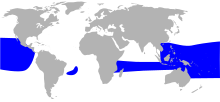
Back Grootfregatvoël AF فرقاط كبير Arabic فرقاط كبير ARZ Fregata minor AST Голяма фрегата Bulgarian Fregata minor BR Fregata gran Catalan Fregata minor CEB Fregatka obecná Czech Aderyn ffrigad mawr CY
| Great frigatebird | |
|---|---|

| |
| Adult male, displaying, with inflated gular sac | |
| Scientific classification | |
| Domain: | Eukaryota |
| Kingdom: | Animalia |
| Phylum: | Chordata |
| Class: | Aves |
| Order: | Suliformes |
| Family: | Fregatidae |
| Genus: | Fregata |
| Species: | F. minor
|
| Binomial name | |
| Fregata minor (Gmelin, 1789)
| |

| |
| Range map | |
| Synonyms | |
|
Pelecanus minor Gmelin 1789 | |
The great frigatebird (Fregata minor) is a large seabird in the frigatebird family. There are major nesting populations in the tropical Pacific Ocean, such as Hawaii and the Galápagos Islands; in the Indian Ocean, colonies can be found in the Seychelles (on Aldabra and Aride Islands) and Mauritius, and there is a tiny population in the South Atlantic, mostly on and around St. Helena and Boatswain Bird Island (Ascension Island).
The great frigatebird is a large and lightly built seabird up to 105 cm long with predominantly black plumage. The species exhibits sexual dimorphism; the female is larger than the adult male and has a white throat and breast, and the male's scapular feathers have a purple-green sheen. In the breeding season, the male is able to distend his striking red gular sac. The species feeds on fish taken in flight from the ocean's surface (mostly flying fish), and indulges in kleptoparasitism less frequently than other frigatebirds. They feed in pelagic waters within 80 km (50 mi) of their breeding colony or roosting areas.
- ^ BirdLife International (2020). "Fregata minor". IUCN Red List of Threatened Species. 2020: e.T22697733A163770613. doi:10.2305/IUCN.UK.2020-3.RLTS.T22697733A163770613.en. Retrieved 12 November 2021.
